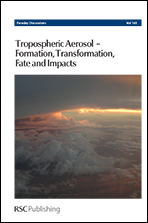Including phase separation in a unified model to calculate partitioning of vapours to mixed inorganic–organic aerosol particles†
Abstract
A simple approach to calculate liquid–liquid phase separation has been developed based on the derivation of partitioning coefficients between multiple liquid phases and inclusion in a framework used to partition an arbitrary number of compounds between the vapour and particle phases in an atmospheric aerosol. The representation compares favourably with a more complex and expensive benchmark gas-particle thermodynamic model for simple well-constrained systems. The model has then been applied to consider liquid phase separation in multicomponent particles formed by the equilibration of organic products generated by a near-explicit model of VOC oxidation. Inclusion of phase separation decreases the predicted mass of condensed organic material by ∼10 to ∼50%, dependent on the concentration of semi-volatile components and ambient conditions in the model scenario. The current study considers only two liquid phases, but the framework can readily accommodate an arbitrary number, though this is beyond the scope of the current work. Uncertainty introduced by the omission of phase separation is far lower than existing uncertainties in pure component vapour pressures, where orders of magnitude differences in predicted mass are found, though the bias introduced when choosing a particular method for estimating the saturation vapour pressure will influence the magnitude of phase separation. The proposed technique is the first to be used to practically deal with the many hundreds or thousands of components present in the ambient atmospheric aerosol.
- This article is part of the themed collection: Tropospheric Aerosol – Formation, Transformation and Impacts

 Please wait while we load your content...
Please wait while we load your content...